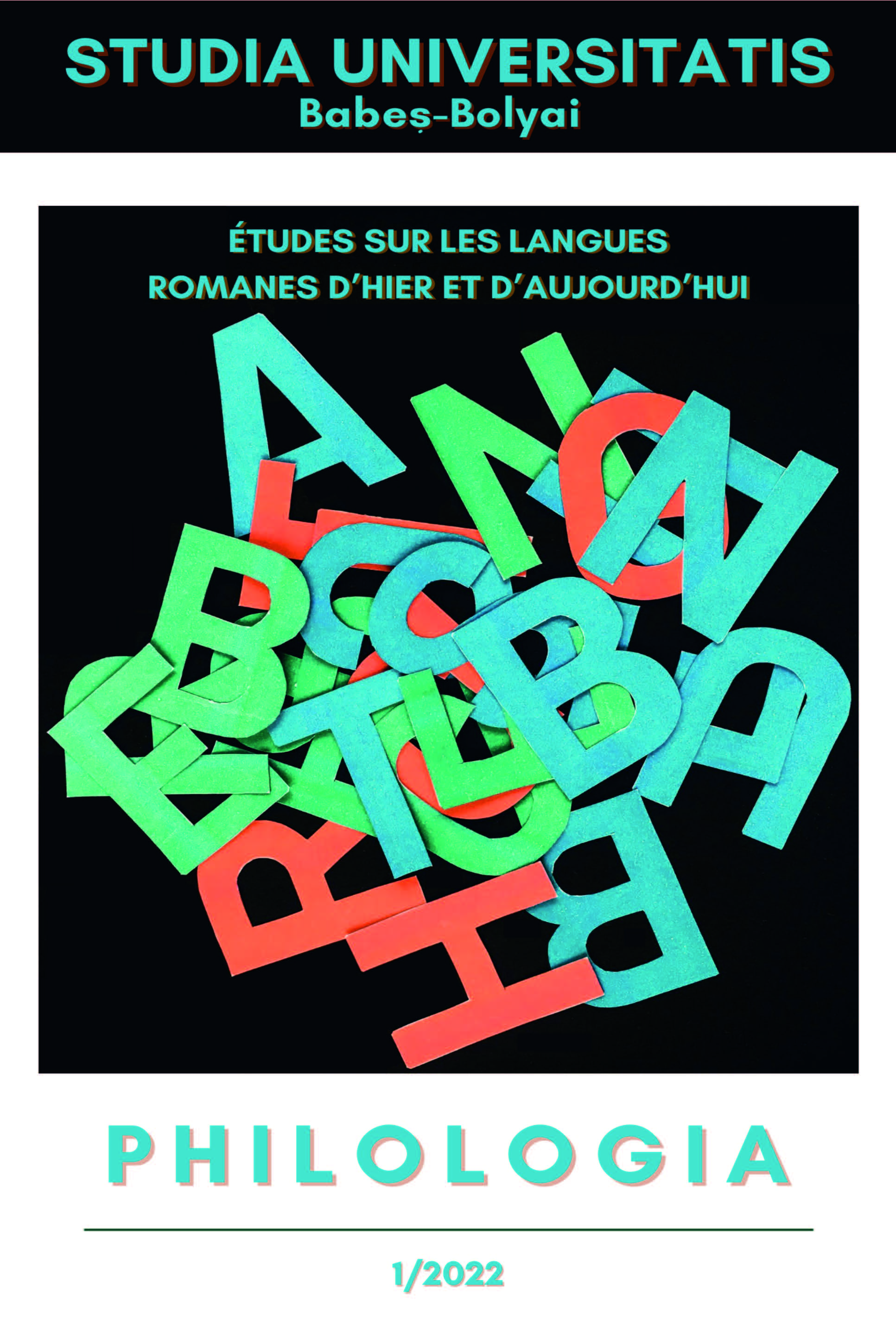CONSIDERACIONES EN TORNO A LOS BINOMIOS NOMINALES EN DOCUMENTOS DE LA AUDIENCIA DE QUITO DE LOS SIGLOS XVI Y XVII
DOI:
https://doi.org/10.24193/subbphilo.2022.1.04Keywords:
binomials, Audience of Quito, historical American Spanish, the 16th and 17th centuriesAbstract
Considerations on Nominal Binomials in Documents of the Audience of Quito in the 16th and 17th Centuries. The phenomenon of binomials is very widespread in Spanish and is witnessed from its first texts. In the present work, the nominal binomial structures are analyzed in a corpus of documents of the Audiencia of Quito from the 16th and 17th centuries, since, in the history of the Spanish language, we are far from knowing the dynamics of the binomials in the American viceregal documentation. We will present some of the representative characteristics of the bimembre technique as a fact of writing the American documentation, insisting on its variational dimension.
Article history: Received 1 September 2021; Revised 20 October 2021; Accepted 11 November 2021; Available online 31 March 2022; Available print 31 March 2022.
REZUMAT. Consideraţii privind binoamele nominale în documente din Audiencia de Quito din secolele al XVI-lea şi al XVII-lea. Fenomenul binoamelor este răspândit în spaniolă și este atestat încă din primele texte. În studiul de faţă, sunt analizate structurile binomiale cu nucleu nominal într-un corpus de documente provenind de la Audiencia de Quito din secolele XVI și XVII, întrucât, în ceea ce priveşte istoria limbii spaniole, suntem departe de a cunoaște dinamica binoamelor în documentația viceregală americană. Vom prezenta câteva caracteristici reprezentative ale tehnicii bimembre ca fapt al redactării documentației americane, insistând asupra dimensiunii sale variaționale.
Cuvinte-cheie: binom, Audiencia de Quito, spaniola americană istorică, secolele al XVI-lea şi al XVII-lea
References
Andrades, Arsenio. 2016. “Propuesta de equivalencias de binomios en la traducción jurídica inglés-español.” Estudios de Traducción, 6, 129-45.
Buesa Oliver, Tomás, Enguita Utrilla, José María. 1992. Léxico del español de América. Su elemento patrimonial e indígena. Madrid: Editorial Mapfre.
Codita, Viorica. 2016. Conformación y uso de las locuciones prepositivas en castellano medieval. Madrid-Frankfurt: Editorial Iberoamericana-Vervuert Verlag.
Codoñer Merino, Carmen. 1972. “Léxico de las fórmulas de donación siglo X.” Emerita, 40(1), 141-149.
CORDIAM = Corpus diacrónico y diatópico del español de América, coordinado por Concepción Company Company y Virginia Bertolotti, México, Universidad Nacional Autónoma de México, www.cordiam.org (consulta: 26/01/2017).
CORPES XXI = Real Academia Española, Corpus del español del siglo XXI, www.rae.es (consulta: 14/03/2018).
Del Rey Quesada, Santiago. 2017. “Grupos paratácticos en la traducción del dialogo renacentista”. Romanische Sprachgeschichte und Übersetzung, editado por Heidi Aschenberg, Sarah Dessì Schmid, 115-38. Heidelberg: Winter Verlag.
Diez de Revenga Torres, Pilar. 1985-1986. “Análisis de las lexías complejas en documentos medievales murcianos.” Estudios de Lingüística Universidad de Alicante (ELUA), 3, 193-208.
Egido, Cristina, 2016. “América vs. España: contrastes gramaticales y léxicos en documentación del siglo XVII.” En la estela del Quijote: Cambio lingüístico, normas y tradiciones discursivas en el siglo XVII, editado por Marta Fernández Alcaide, Elena Leal Abad, Álvaro. S. Octavio de Toledo y Huerta, 189-213. Frankfurt: Peter Lang Verlag.
Fernández Alcaide, Marta, Leal Abad, Elena. 2016. “Nuevas aportaciones al estudio de la lengua y los textos del XVII.” En la estela del Quijote: Cambio lingüístico, normas y tradiciones discursivas en el siglo XVII, editado por Marta Fernández Alcaide, Elena Leal Abad, Álvaro. S. Octavio de Toledo y Huerta, 27-44. Frankfurt: Peter Lang Verlag.
Fernández-Ordóñez, Inés, 2004. “Alfonso X el Sabio en la historia del español.” Historia de la lengua española, editado por in Cano Aguilar, Rafael, 381-422. Barcelona: Editorial Ariel.
Koch, Peter, Oesterreicher, Wulf. 2001. “Langage parlé, langage écrit.” Lexikon der Romanistischen Linguistik, I/2, editado por Günter Holtus, Michael Metzeltin, Christian Schmitt, 584-627. Tübingen: Max Niemeyer Verlag.
Koch, Peter, Oesterreicher, Wulf. 2007 [1990]. Lengua hablada en la Romania: español, francés, italiano. Madrid: Editorial Gredos.
Lagüéns Gracia, Vicente. 1992. “Semántica jurídica: binomios léxicos en la prosa notarial.ˮ Actas del II Congreso Internacional de Historia de la Lengua, editado por Manuel Ariza, Rafael Cano, J. Mendoza, Antonio Narbona. Madrid: Pabellón de la Lengua Española, 1121-28.
Malkiel, Yakov. 1959. “Studies in irreversible binomials.” Lingua, 8(2), 113-55.
Martínez Ortega, María de los Ángeles. 1999. “La iteración sinonímica en la lengua jurídica de los siglos XVI y XVII.” Iberoromania, 49, 26-37.
Oesterreicher, Wulf. 1994. “El español en texto escritos por semicultos. Competencia escrita de impronta oral en la historiografía indiana.” El español de América en el siglo XVI, editado por in Jens Lüdtke, 155-90. Madrid-Frankfurt: Editorial Iberoamericana-Vervuert Verlag.
Puche Lorenzo, Miguel Ángel. 2002. El español del siglo XVI en textos notariales. Murcia: Universidad de Murcia.
Rivarola, José Luis. 1999. “Sinonimias colombinas, sinonimias lascasianas.” Revista de Filología Española, 79(½), 33-64.
Sánchez Méndez, Juan. 1997. Aproximación histórica al español de Venezuela y Ecuador durante los siglos XVII y XVIII. Valencia: Editorial Tirant lo Blanch.
Sánchez Méndez, Juan Pedro. 2014. “Historia externa y lingüística histórica en los documentos coloniales hispanoamericanos.” Dándole cuerda al reloj: ampliando perspectivas en lingüística histórica de la lengua española, editado por Vicente Álvarez Vives, Elena Diez del Corral Areta, Natacha Reynaud Oudot. Valencia: Editorial Tirant lo Blanch, 66-89.
Sánchez Méndez, Juan Pedro (coord.), Viorica Codita, Antonio Corredor Aveledo, Martha Guzmán Riverón, y Elena Padrón Castilla. 2018. Documentos para la historia lingüística de la Audiencia de Quito (Siglos XVI-XIX). Madrid: Consejo Superior de Investigaciones Científicas.
Sánchez-Prieto Borja, Pedro. 2015. “El léxico de la General Estoria de Alfonso X el Sabio.” Anuario de Estudios Medievales, 45(1), 17-53.
Saralegui, Carmen, Pérez-Salazar, Carmela. 1992. “Coordinación de binomios en textos jurídicos.” RILCE, 8(1), 112-33.
Smith, Colin. 1977. “Realidad y retórica: el binomio en el estilo épico.” Estudios cidianos, 163-217. Madrid: Cupsa Editorial.
Tabares Plasencia, Encarnación. 2016. “Fraseología jurídica y variación topolectal.” Onomazéin, 33, 1-15.
Downloads
Published
How to Cite
Issue
Section
License
Copyright (c) 2022 Studia Universitatis Babeș-Bolyai Philologia

This work is licensed under a Creative Commons Attribution-NonCommercial-NoDerivatives 4.0 International License.



